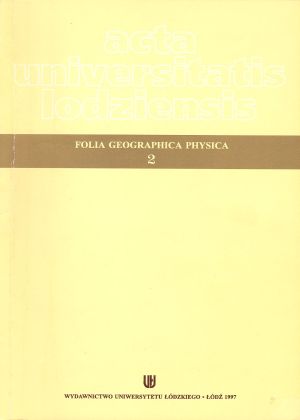Źródła północno-zachodniej części Masywu Śnieżnika
Springs of the North-Western part of the Śnieżnik Massif
Author(s): Zygmunt Maksymiuk, Edmund TomaszewskiSubject(s): Environmental Geography
Published by: Wydawnictwo Uniwersytetu Łódzkiego
Summary/Abstract: The evaluation of the spring regime lets us characterize some hydrogeological features of the researched area and determine the influence of the so called point drainage on a layout and quantity of water which supplies the river network. It refers especially to the mountaineous areas. A good example is the metamorphic Śnieżnik Massif, where due to the lack of representative hydrogeological bore-holes a number of springs are the only sign of the underground water circulation.The hydrographical mapping of the researched area was carried out in July 1994. This period was characterized by an evident shortage of precipitations and by high temperatures of air. They researched the Wilczka drainage basin down to the Wilkanów profile and all the upper parts of the Nowinka, Domaszkowski Potok, Szklarka and Czarna Woda drainage basins (fig. 1). There were observed 212 natural underground water outflows there, of which162 were real springs, 38 sapping springs and 12 bog-springs.The analysis of the observed spatial diversity of the underground water outflows was carried out basing on the elementary measures referred to the areas of the autochthonous and def Terenliated drainage basins. Those basic measures are: springability coefficient, springwater run of T modulus and the participation of the spring water in the combined runoff (fig.2, 3, 4, 5). They noticed evident connections with relief, geology Le. characteristics of the underground water basins, drained by springs.The vertical diversity of the researched springs was examined either in the zonalheight-intervals or actual altitude (precise fixing of an altitude) (fig. 6, 7, 8, 9). The quantity of the outflows and their features (temperature, yield) were estimated on the statistical characteristics of the studied series. There were not observed any very evident connections of the analyzed characteristics with an altitude. The authors observed a tendency to constitute height-intervals in which the character and the regime of the springs are similar. The causes for such a state should be searched in orographic and geological features, which are combined with the occurence of definite groups of outflows on the proper altitude.
Journal: Acta Universitatis Lodziensis. Folia Geographica Physica
- Issue Year: 2/1997
- Issue No: 2
- Page Range: 45-59
- Page Count: 15
- Language: Polish

